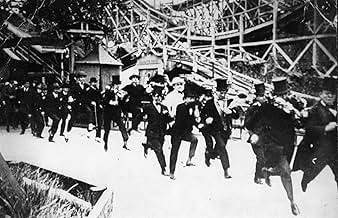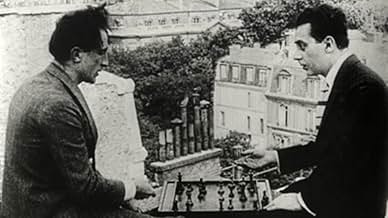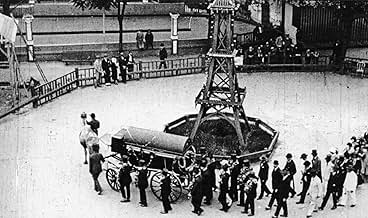Entr'acte
- 1924
- 22 Min.
IMDb-BEWERTUNG
7,3/10
4354
IHRE BEWERTUNG
Füge eine Handlung in deiner Sprache hinzuAn absolute dada movie. Somebody gets killed, his coffin gets out of control and after a chase it stops. The person gets out of it and let everybody who followed the coffin dissapear.An absolute dada movie. Somebody gets killed, his coffin gets out of control and after a chase it stops. The person gets out of it and let everybody who followed the coffin dissapear.An absolute dada movie. Somebody gets killed, his coffin gets out of control and after a chase it stops. The person gets out of it and let everybody who followed the coffin dissapear.
Inge Frïss
- La ballerine
- (as Mlle Frïss)
Man Ray
- Un joueur d'échecs
- (as Man-Ray)
Marcel Achard
- Un homme qui suit le corbillard
- (Nicht genannt)
Georges Auric
- Un homme qui suit le corbillard
- (Nicht genannt)
Georges Charensol
- Un homme qui suit le corbillard
- (Nicht genannt)
Georges Lacombe
- Un homme qui suit le corbillard
- (Nicht genannt)
Roger Le Bon
- Un homme qui suit le corbillard
- (Nicht genannt)
Jean Mamy
- Un homme qui suit le corbillard
- (Nicht genannt)
Rolf de Maré
- Un homme qui suit le corbillard
- (Nicht genannt)
Erik Satie
- Un homme qui charge le canon
- (Nicht genannt)
Pierre Scize
- Un homme qui suit le corbillard
- (Nicht genannt)
Louis Touchages
- Un homme qui suit le corbillard
- (Nicht genannt)
Empfohlene Bewertungen
We were shown this film in a class where at least once during each class, I start to nod off to sleep. Maybe it's the time of day, or the too-dark lights, but even during one of the Jean Vigo films we saw it didn't grab me. This one did, however, as it is one of the best short films of the 20's, or at least one of the more ambitious ones of the time. There are plenty of Freudian symbols, or maybe spoofs and in-jokes on the symbols (i.e. phallic imagery, cannons, guns, balls, and obsessions with looking up women's skirts).
But more importantly there is an almost need to break through anything expectable. Unlike Bunuel's Un Chien Andalou, however, Entr'acte even goes for the manic and cartoon-like. Like Bunuel's film, there COULD be a certain thread of a story in the proceeding, if you try to take one to mind- here the story could be the unexpected tragedy of death turned up on its own head. However there is also the latter part of the film, which involves a large group running after (in trademark, hilarious fast-motion film) a hearse running down a road. It's a kind of peak of stimulating silent-film cinema, where everything being done can now be just as easily done- and is- on a daily basis by music video directors.
Yet Clair is so inventive with his techniques, of pushing a speed and tempo with his style, that it works well despite making no sense on the surface. It's a film made in the heights of French impressionism and surrealism, and the almost sheer confidence of the filmmaker here propels it into being unforgettable in a way. Most will seek out the Bunuel early works first, of course, but along the way this is worth a shot. At the least, you'll have your own interpretation once its done, not shoved down your throat.
But more importantly there is an almost need to break through anything expectable. Unlike Bunuel's Un Chien Andalou, however, Entr'acte even goes for the manic and cartoon-like. Like Bunuel's film, there COULD be a certain thread of a story in the proceeding, if you try to take one to mind- here the story could be the unexpected tragedy of death turned up on its own head. However there is also the latter part of the film, which involves a large group running after (in trademark, hilarious fast-motion film) a hearse running down a road. It's a kind of peak of stimulating silent-film cinema, where everything being done can now be just as easily done- and is- on a daily basis by music video directors.
Yet Clair is so inventive with his techniques, of pushing a speed and tempo with his style, that it works well despite making no sense on the surface. It's a film made in the heights of French impressionism and surrealism, and the almost sheer confidence of the filmmaker here propels it into being unforgettable in a way. Most will seek out the Bunuel early works first, of course, but along the way this is worth a shot. At the least, you'll have your own interpretation once its done, not shoved down your throat.
This is an avant-garde movie and as such it's theme and plot are unclear, which is as intended because the movie is ore about special effects than about telling an actual story. This movie directs the audiences' attention to such everyday occurrences as movement, personal interactions, dancing, and running. People are part of some kind of funeral procession, but what catches the attention is the various actions that take place as the procession proceeds. Mourning is replaced by an almost frenetic need to stay active, and the movie shows this through the use of some innovative techniques, including slow-motion, use of montage, and multiple superimposed exposures, all of which convey the sense that something intense is happening. This movie is an excellent example of the French avant-garde genre which had a major influenced on cinematic styles in Europe and the United States.
René Clair's "Entr'acte" is one of the pioneering films of the surrealist genre in cinema, which, from what I gather, is the attempt at bending reality and twisting all that we've come to know into something deeply strange but entirely mesmerizing. Heavy on its use of perverse or unique imagery and juxtaposition of images and sequences and frequently rejecting the conventions of linear, dramatic filmmaking, such surrealist filmmakers today, such as Quentin Dupieux and Terry Gilliam, focus on a wide-range or visual styles in addition to wacky, out-there humor that is sometimes funny because it doesn't make a bit of sense (otherwise known as "anti-humor").
When it comes to "Entr'acte," however, we have an intriguing piece of film on our hands, one that serves as an early film of the "dadaism" movement in art, where European artists, writers, poets, filmmakers, and theorists began to reject commonly- utilized devices in art of the time in favor of a more radical approach to their mediums. These often included the injection of leftist policies and believes, most specifically anti-war policies that began hitting their stride as World War II neared.
Just by watching the first few minutes of "Entr'acte," one can see that it has no desire at all to try and fit in with conventional artistic standards. It serves as a conglomerate of visuals from the dadaist period, many of which not making very much sense, but each provoking a genre-bending fascination amongst the audience. The opening scene itself is something to marvel at, showing two people firing a cannon from the top of a large building, while strangely-calming and infectious music is played in the background.
The film persists on, with numerous different visuals that were likely never before seen outside of this particular work. What's remarkable is that despite the film's age, scenes involving characters running in slow motion and then being sped up into running in fast-motion after a vehicle still hold a certain kind of power to them. Overall, there's a mesmerizing quality "Entr'acte" bears that is surprising to note seeing as it perfectly defines a film that was "the first of its kind."
Directed by: René Clair.
When it comes to "Entr'acte," however, we have an intriguing piece of film on our hands, one that serves as an early film of the "dadaism" movement in art, where European artists, writers, poets, filmmakers, and theorists began to reject commonly- utilized devices in art of the time in favor of a more radical approach to their mediums. These often included the injection of leftist policies and believes, most specifically anti-war policies that began hitting their stride as World War II neared.
Just by watching the first few minutes of "Entr'acte," one can see that it has no desire at all to try and fit in with conventional artistic standards. It serves as a conglomerate of visuals from the dadaist period, many of which not making very much sense, but each provoking a genre-bending fascination amongst the audience. The opening scene itself is something to marvel at, showing two people firing a cannon from the top of a large building, while strangely-calming and infectious music is played in the background.
The film persists on, with numerous different visuals that were likely never before seen outside of this particular work. What's remarkable is that despite the film's age, scenes involving characters running in slow motion and then being sped up into running in fast-motion after a vehicle still hold a certain kind of power to them. Overall, there's a mesmerizing quality "Entr'acte" bears that is surprising to note seeing as it perfectly defines a film that was "the first of its kind."
Directed by: René Clair.
While not nearly as well-recognized or well-remembered as the Luis Bunuel classic "Un Chien Andalous" (1929), "Entr'acte" is a fairly known work in Dadaism of the 1920's, possibly one of the earliest shorts to focus on the avant-garde rather then attempt a story. Intended as an "entr'acte" (so the title suggests) for the French ballet "Relâche", the film appears to be a mere experimentation with effects while crafting a rather odd plot in the process--and more of a plot than most of the surrealistic works contain. Quite sadly, it was Rene Clair's only attempt at such a form of filmmaking, and had he gone on to lead the movement further he may have come up with even crazier material.
The image most of us remember when we think of this movie (if we do think of this movie, which many may not) is the shot of the bearded ballet dancer, reportedly played by Clair himself. This is a rather odd sight to see in a movie, and one you wouldn't normally see--likewise the rest of the short. Experimenting with slow motion, reverse motion, upside-down and side-to-side camera angles, and a number of dizzying double-exposures, the film's narrative is a rather odd one of a man shooting at a large egg only to be murdered by another man afterwards. This sets up the strange premise and the rest of the film is largely a crazy chase as the mourners of the man pursue his coffin after the hearse gets out of control. The ending, not to be spoiled, (although already spoiled by IMDb's summary) is a weird one to boot.
As others have commented, this short is hardly dark and is more of a comedy to watch than the later surrealist efforts. Plus, the opening sequences (such as the balloon dolls) hardly have anything to do with the rest of the short and the ballet dancer is entirely unconnected to the rest of it. It feels as though they were taking the first few minutes to experiment with other visuals before progressing with the true 'narrative', if one could call it that. Not to be considered a surrealist film, however; the wonderfully dizzying use of exposures is pure Dada all the way. A very creditable early effort in its exceedingly memorable imagery, and every bit as deserving to be a landmark classic as "Un Chien Andalou".
The image most of us remember when we think of this movie (if we do think of this movie, which many may not) is the shot of the bearded ballet dancer, reportedly played by Clair himself. This is a rather odd sight to see in a movie, and one you wouldn't normally see--likewise the rest of the short. Experimenting with slow motion, reverse motion, upside-down and side-to-side camera angles, and a number of dizzying double-exposures, the film's narrative is a rather odd one of a man shooting at a large egg only to be murdered by another man afterwards. This sets up the strange premise and the rest of the film is largely a crazy chase as the mourners of the man pursue his coffin after the hearse gets out of control. The ending, not to be spoiled, (although already spoiled by IMDb's summary) is a weird one to boot.
As others have commented, this short is hardly dark and is more of a comedy to watch than the later surrealist efforts. Plus, the opening sequences (such as the balloon dolls) hardly have anything to do with the rest of the short and the ballet dancer is entirely unconnected to the rest of it. It feels as though they were taking the first few minutes to experiment with other visuals before progressing with the true 'narrative', if one could call it that. Not to be considered a surrealist film, however; the wonderfully dizzying use of exposures is pure Dada all the way. A very creditable early effort in its exceedingly memorable imagery, and every bit as deserving to be a landmark classic as "Un Chien Andalou".
Rene Clair and the Marx Brothers once decided to make a movie together: it's a shame that it never happened. Maybe that movie exists in some alternate universe, and I'll bet it's hilarious. I enjoyed "Entr'acte", but I'd gladly trade this film for a chance to see Rene Clair's Marx Brothers movie.
Another IMDb reviewer has synopsised the plot, such as it is: a man apparently dies. After his funeral, his coffin escapes from its hearse, and then the man returns to life. The title "Entr'acte" (an interval between theatrical acts, or an intermission) is never explained; maybe it refers to the interval between that man's two lives. I prefer to think that Clair meant this somewhat amateurish film as a mere intermission: an amusing bit of fun between the acts of his 'real' films; the ones with coherent story lines.
Some of the content in this film truly does seem to be unintentional. After the central character's funeral, there's a stiff wind blowing outside the chapel. The women in this movie wear elaborate long dresses, and the wind animates their clothing in a way that's distracting rather than funny, and surely not meant to be symbolic.
Much of the imagery in this movie seems to be pure Dada rather than signifying anything. The man's funeral cortege is led by a camel. If there's any underlying significance there, I doubt that it amounts to much. Earlier on, I was intrigued by one sequence featuring Parisian chess players. While the camera focuses on the chessboard, a shot of Parisian traffic is superimposed: suggesting that all humanity are pawns in some cosmic chess game.
Don't look for too much meaning in "Entr'acte". It's an amusing experiment, but might have been more effective at a shorter length.
Another IMDb reviewer has synopsised the plot, such as it is: a man apparently dies. After his funeral, his coffin escapes from its hearse, and then the man returns to life. The title "Entr'acte" (an interval between theatrical acts, or an intermission) is never explained; maybe it refers to the interval between that man's two lives. I prefer to think that Clair meant this somewhat amateurish film as a mere intermission: an amusing bit of fun between the acts of his 'real' films; the ones with coherent story lines.
Some of the content in this film truly does seem to be unintentional. After the central character's funeral, there's a stiff wind blowing outside the chapel. The women in this movie wear elaborate long dresses, and the wind animates their clothing in a way that's distracting rather than funny, and surely not meant to be symbolic.
Much of the imagery in this movie seems to be pure Dada rather than signifying anything. The man's funeral cortege is led by a camel. If there's any underlying significance there, I doubt that it amounts to much. Earlier on, I was intrigued by one sequence featuring Parisian chess players. While the camera focuses on the chessboard, a shot of Parisian traffic is superimposed: suggesting that all humanity are pawns in some cosmic chess game.
Don't look for too much meaning in "Entr'acte". It's an amusing experiment, but might have been more effective at a shorter length.
Wusstest du schon
- WissenswertesThe ballet "Relâche" ("Theatre Closed") premiered at the Théâtre des Champs Elyseés in Paris on December 4, 1924. Based on a book and with settings by Francis Picabia, it was a ballet in two acts commissioned and staged by the Ballets Suédois of Rolf de Maré, with choreography by Jean Börlin. As the title "Entr'acte" implies, this film was shown between the two acts, with music by Erik Satie.
- PatzerObvious stand-in for the close-up of Rolf de Maré getting kicked in head, which sends him (via reverse motion) flying back into the end title. The "kick" itself is clearly achieved through reverse motion.
- Alternative VersionenThere is an Italian edition of this film on DVD, distributed by DNA Srl (2 Films on a single DVD). The film has been re-edited with the contribution of film historian Riccardo Cusin. This version is also available for streaming on some platforms.
- VerbindungenEdited into Avant-garde Cinema (1960)
Top-Auswahl
Melde dich zum Bewerten an und greife auf die Watchlist für personalisierte Empfehlungen zu.
Details
- Laufzeit22 Minuten
- Farbe
- Sound-Mix
- Seitenverhältnis
- 1.33 : 1
Zu dieser Seite beitragen
Bearbeitung vorschlagen oder fehlenden Inhalt hinzufügen























